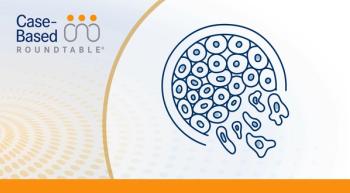
VMP + Daratumumab for High-Risk Multiple Myeloma
C. Ola Landgren, MD:The patient we’re are looking at, the 74-year-old lady who presents with myeloma, could she be a candidate for the ALCYONE combination with daratumumab/melphalan/prednisone/bortezomib? She could. She would fit the criteria if we think of her as a nontransplant candidate. Are there other options she could benefit from? There certainly are. I mentioned before that the use of a proteasome inhibitor and steroids, such as bortezomib and dexamethasone, is recommended by international guidelines. And I also mentioned that the added use of cyclophosphamide, or Cytoxan, to that combination is also endorsed by international guidelines.
The ALCYONE trial using melphalan and prednisone would be equivalent. Or Cytoxan and dexamethasone; you have the alkylator and the steroid. And then you have bortezomib in ALCYONE, which is exactly what the international guidelines have. ALCYONE also, in the experimental arm, had the added benefit from daratumumab.
So, I think for a patient who is looking for a nontransplant design regimen that it could be used. I think it’s probably less commonly used in the United States because of traditions, and there are a lot of other drugs. I think a lot of American doctors probably use CyBorD. They will use bortezomib with Cytoxan (cyclophosphamide) and dexamethasone, while in Europe and in other parts of the world, like in Asia, maybe the ALCYONE combination would be more frequently used. That being said, it would be possible to use this combination here in the United States as well.
What are the practical implications with the ALCYONE combination with bortezomib/melphalan/prednisone/daratumumab? It is a pretty straightforward regimen. Bortezomib has been used for many years. It was initially FDA approved in 2003. The clinical important pieces are that bortezomib should be given subcutaneously, and not intravenously, to avoid peripheral neuropathy. Melphalan and prednisone are oral drugs. So, there is really not a whole lot to consider there.
I think offering patients omeprazole to alleviate the irritation in the stomach from steroids probably is something to consider. And talking of drugs to support and prevent prophylactic strategies, if you give bortezomib, you also need to think about herpes zoster prophylaxis. You need to do Valtrex (valacyclovir hydrochloride) therapy for that. When it comes to the daratumumab drug, that’s the new drug obviously in this combination. Doctors need to think about type-and-screen before the drug is given, because the drug interferes with testing that’s done at the blood bank. If you didn’t do that and you send a sample for type-and-screen, you would get signals that the patient has a Coombs-positive test. You need to notify the blood bank about that.
You also need to give premedication for daratumumab per the label. Other than that, I think it’s pretty straightforward. Daratumumab is given the same way as the FDA label for single drug administration as well as in combination with other drugs, meaning that you give the daratumumab drug once a week for 8 weekly doses. Then it’s every other week for 8 weekly doses, and eventually it turns into every-4-week dosing.
Transcript edited for clarity.
- A 74-year-old woman presented with anemia, proteinuria, renal insufficiency, and pain in her right hip
- History: chronic HTN, aortic insufficiency, diabetes mellitus
- ECOG performance status, 1
- X-Ray of the pelvis showed numerous lytic lesions in the ilium and a large lesion in the right proximal femur
- MRI confirmed a 9-mm lesion in the right femoral head and numerous bilateral T1 hypointense and T2 hyperintense lesions in both iliac region
- Laboratory results:
- Hb, 10.1 g/dL
- Ca2+3.32 mmol/L
- Creatinine, 1.9 mg/dL
- Creatinine clearance, 30 mL/min
- M-protein, 1.4 g/dL
- B2M, 4.9 mcg/mL
- SFLC, kappa, 150 mg/dL
- Bone marrow biopsy, 70% plasma cells
- Molecular testing, del17p







































